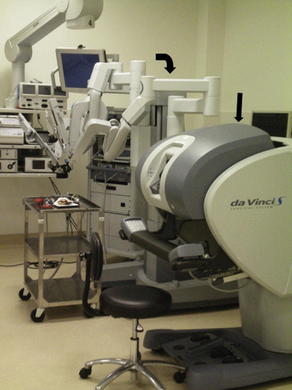Robot-Assisted Plastic Surgery
Keywords
• da Vinci • RAMS • Reconstructive • Robot assisted • Robotic • Surgical • TORS
Overview
The term “robot” derives from the Czech word robota, which means “forced labor”; it was first used by the Czech writer Karel Capek in his play Rossum’s Universal Robots in 1921.1 The concept of robotics in surgery was promoted by the National Aeronautics and Space Administration (NASA) and the US Army to develop telepresence surgery (operating remotely) because of potential wartime and space applications.1 The da Vinci Surgical System (Intuitive Surgical, Sunnyvale, CA) emerged as the prominent commercially available robotic system and the first to be approved by the Food and Drug Administration (FDA) in 2000 (Fig. 1).2 The da Vinci system most commonly is being used in cardiothoracic, gastrointestinal, gynecologic, and urological operations; more than 205,000 robot-assisted procedures are performed annually, with a rapidly growing number of hospitals installing systems.3 Because plastic surgery operations primarily do not involve organ-containing body cavities, technologies, such as laparoscopy, that have revolutionized several surgical subspecialties have not had a major impact in plastic surgery. The surgical robot may have applications in plastic surgery that can provide technical advantages, however, particularly in robot-assisted microsurgery (RAMS) and transoral robotic surgery (TORS). The purpose of this article was to investigate current and potential uses of the surgical robot in plastic surgery, as well as obstacles to its use.
Therapeutic options
RAMS
In the mid-1990s, investigators expanded on the previously developed NASA telerobotics systems to create a robot assistant suitable for microsurgery that consisted of a 10-inch-long manipulator with 6° of freedom.4,5 By 1998, technical feasibility animal studies demonstrated robotic instruments to be capable of successfully anastomosing coronary arteries through both open and endoscopic techniques.6,7 Further efficacy and benefits of the microsurgical robotic system included the ability to perform closed-chest multivessel cardiac bypass and beating heart bypass operations.6,8 By 2000, the next generation of surgical robots progressed and comprised a robot slave and surgeon-controlled command center; the da Vinci Surgical System was FDA approved for human use.8 Using 3-dimensional stereoscopic vision and robotic slave arms equipped with instruments, the technology allowed the surgeon to work at a smaller scale than conventional surgery; for microsurgery, this meant potentially greater technical quality and a lower error rate. Comparative studies analyzing microvascular anastomoses concluded that patency and leak rates between traditional microsurgery techniques and robot-enhanced techniques were equivalent; however, the surgical robot group took twice as long.7,9,10 The robot-enhanced cases had remarkable tremor filtration at a cost of prolonged operating time.9
The surgical robot enhances microsurgical precision by suppressing involuntary movements of tremor and low frequency drift.11,12 The robot standardizes the vascular anastomotic technical skills and may reduce variations in patient outcomes.11 Furthermore, the robot can limit the affect of fatigue, anxiety, or age-related factors.13 This occurs owing to scalability of movements up to 1:6 scale, meaning that 6-mm finger movement will result in 1-mm motion of the instrument. Simultaneously available magnification of the operative field and scalability of maneuvers synergistically enhances a microsurgeon’s technical capability. RAMS also provides more range of motion and degrees of freedom than the human hand, creating more potential maneuverability during free flaps, replantation, or microneurorrhaphy.
Investigators found that robotic microsurgery skills could be expeditiously learned by residents and practicing surgeons.14 The da Vinci robot was used to successfully perform a free flap in a porcine model anastomosing a 1.5-mm and 1.3-mm artery and vein, respectively; the authors concluded a similar setup time to the operating microscope and comparable warm ischemia time of the flap.15 Robotic assistance was used for distal ulnar artery reconstruction with a forearm venous graft in a patient with bilateral hypothenar hammer syndrome.16 Robotic-assisted microvascular anastomoses are being performed during reconstruction after transoral robotic surgical resection of oropharyngeal tumors by use of a third arm with the da Vinci system.17–19
TORS
Traditional open access surgical resection commonly was used for the treatment of oropharyngeal tumors; operations often involved mandibular osteotomy and were associated with patient morbidity and poor functional outcome.20 Management of these cancers with surgical ablation declined in favor of chemoradiation, which was shown to be effective while preserving anatomy21–23; however, complications such as toxicity and dysphagia occur with chemoradiation treatment.24 TORS is now being used for oropharyngeal tumor resection at some institutions.25–29 TORS facilitates exposure to the oropharynx, hypopharynx, larynx, and parapharyngeal space without requiring mandibulotomy for tumor excision. Morbidity with TORS is minimized compared with transmandibular or translabial resection; TORS can provide tissue to allow for staging and thus possibly minimize the amount of radiation treatment required.30
TORS for head and neck tumor extirpation with the da Vinci system has been FDA approved since 2009. As TORS has become an option for oncological resection, the development of robot-assisted reconstruction following ablative TORS is most relevant to reconstructive surgeons. Selber and colleagues17 described a preclinical study of TORS reconstruction using cadaveric and porcine models and a case series.18 These investigators have performed 20 cases of TORS reconstruction, including anterolateral thigh flaps, radial forearm flaps, ulnar artery perforator flaps, facial artery myomucosal flaps, and buccal or pharyngeal transposition flaps; robot assistance was used for microvascular anastomosis.19 Their preference for selecting TORS for reconstruction is guided by clinical features of the malignancy19:
Stay updated, free articles. Join our Telegram channel

Full access? Get Clinical Tree









